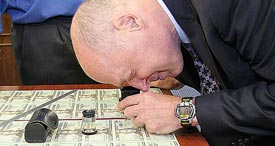The US Dollar Still Stuck In a Rut
Currencies / US Dollar Oct 19, 2007 - 09:55 AM GMT Jack Crooks writes: The finance ministers of six leading nations — Germany, France, Italy, Britain, Canada, and Japan — will meet with Treasury Secretary Henry Paulson in Washington today. And you can bet there's one topic they'll definitely want to discuss — the falling dollar.
Jack Crooks writes: The finance ministers of six leading nations — Germany, France, Italy, Britain, Canada, and Japan — will meet with Treasury Secretary Henry Paulson in Washington today. And you can bet there's one topic they'll definitely want to discuss — the falling dollar.
How could they not? The dollar is as distressed as ever … the Canadian loonie is trading at multi-decade highs … and the euro has hit levels never before seen.
Remember, these currency moves aren't abstract … they greatly affect the world economy and individual trading partners. A cheaper dollar makes U.S. exports far more competitive in the global marketplace. Conversely, nations with stronger currencies lose a bit of their edge.
Foreign businesses have been crying out for help! One example: BusinessEurope, an organization representing overseas firms, has asked the G7 to intervene and stem a further rise in the euro (or additional downside in the buck).
 |
| Henry Paulson is certainly aware of the dollar's shrinking value … |
Now, a lot of people lobby the G7 to do a lot of things so it's not like they aren't used to meeting under pressure. However, the issue has become so important and so high-profile that Paulson and the other finance ministers will at least have to discuss the topic.
The question for currency investors is whether or not anything meaningful will come out of the discussions. My answer: Probably a lot of banter and not much else.
After all, markets dictate currency moves, not finance ministers! That's why I think you need to pay far more attention to what's actually happening in the world right now.
Look, the dollar's fate rests far more on the uncertainty in the U.S. economy than it does on any meeting in Washington. Nevertheless, G7 ministers will be careful not to completely ignore the dollar's weakness because that would send the market a flashing green light to sell the buck even more.
 |
| However, you shouldn't expect much more than talk to come out of the G7 meeting. |
Regardless of how the market translates the G7 message, no mention of dollar weakness would implicitly mean these ministers have no problem with an ongoing, orderly dollar decline — a big mistake.
Warning flags are flying. This idea of allowing the dollar to decline can quickly lead to a crisis. Desperate times call for desperate measures, so they say. And unfortunately, for the buck, the U.S. economy can't accommodate desperate measures right now.
And that's why today, I want to address …
Two Forces That Will Greatly Affect The Dollar's Future Direction
Force #1: The Health of the U.S. Consumer
Many smart people have spent many long hours studying how consumers respond to various economic developments.
Reason: American shoppers make up a massive chunk of the U.S. economic pie — more than 70% of U.S. gross domestic product! Thus, if the U.S. consumer goes, so goes the U.S. economy.
I carefully examine consumer data month in and month out. And much to my surprise, month after month, U.S. consumers remain resilient despite the apparent dangers surfacing throughout the economy.
What are those dangers? Here's a quick recap:
First, new bits of poor housing data are chipping away at consumers' spending power. Much of the equity earned on homes during the real estate boom has been counteracted in a hurry — demand for houses has tanked, and prices are subsequently falling.
Second, global credit markets have tightened after a wave of bad subprime loans led to major securitized debt losses. Because investment banks, hedge funds and other high-risk investors made bad bets, it has now become harder for the average consumer to borrow money.
Third, energy prices have climbed to record levels over the last year. Oil is now inches away from $90 a barrel, and every step higher puts a considerable dent in consumers' discretionary income. The choice is becoming: Designer jeans or a full tank of gas … not a tough one to make!
Fourth, the employment situation in this country is foggy at best. We just learned that the jobless claims rose very sharply last week, the biggest jump since early February. If the U.S. labor market weakens substantially, it will be the straw that breaks the consumer's back! I will be closely monitoring the employment situation for additional signs of weakness.
It's worth repeating: Don't underestimate the power of the U.S. consumer! If shoppers manage to hang in there and buoy the economy, the dollar could stage a strong comeback. However, if (some say "when") U.S. shoppers finally stop binging, the resulting economic pain could send the dollar even lower.
Force #2: The Fed's ability to quell inflation in the U.S.
Let's face it, prices are rising on everything from precious metals to food. And the Federal Reserve often seems unwilling to recognize these threats. Are they aware of these things? Certainly! But are they ready to take them head on or admit that they're a major problem? Hard to say.
The Fed keeps its cards close to the vest, and investors need to play the hands as they come. Basically, the Fed sets the house rules, which go something like this:
Rule #1: Focus on the core measures of inflation for all decisions (i.e. exclude food and energy). These figures won't deviate from previously stated targets as much as headline figures will. Don't forget to print dollars.
Rule #2: If the data begins straying from the current policy outlook, firmly reiterate the original outlook. Once the data has clearly moved against this outlook, quickly reverse course and appear confident in this maneuver. And don't forget to print dollars.
Rule #3: No matter what happens, don't forget to print dollars!
You can see these rules in action just by looking at the August credit crunch. The Fed's response involved slashing rates and pumping money into the financial system. Plus, their attention focused squarely on growth even though all their previous warnings had been about serious inflation threats.
And what about that core inflation focus? After all, the most recent Consumer Price Index data showed a 2.8% price increase in September, much faster than the 2.1% rise in core prices over the same period.
Is the Fed conveniently ignoring gasoline and food prices, which are legitimate costs that weigh on consumers?
It's easy to say yes, but the real answer isn't so simple. The Fed consistently looks at core prices — what they believe is the best measure in determining monetary policy. But regardless of what they believe, the market creates its own expectations. And the Fed does not always comply with those wishes.
Bottom line: The dollar will hit the floor hard if the Fed refuses to accept the market's perception that inflation is a real concern, barreling down on the consumer like a freight-train full of concrete.
My Conclusion: The Buck Is Still Stuck in a Deep Rut
The Federal Reserve's benchmark interest rates appear to be capped, and the only wiggle room is on the downside. In fact, I expect at least another 50 basis points of easing before the first quarter of 2008 comes to a close.
The result for U.S. citizens is a loss of purchasing power, even as prices are rising across the board. This is precisely why there's never been a better time to shield yourself from the ravages of rising prices and plummeting greenbacks.
Finding suitable investments has never been easier, either. You have a whole new world of currency instruments at your disposal. Many can be bought and sold in regular brokerage accounts. You don't need deep pockets. And they offer you the chance to protect your portfolio and potentially make substantial profits.
I encourage you to explore those possibilities. After all, the G7 can comment on exchange rates all they want, but the markets have the only voice that counts.
Best wishes,
By Jack Crooks
This investment news is brought to you by Money and Markets . Money and Markets is a free daily investment newsletter from Martin D. Weiss and Weiss Research analysts offering the latest investing news and financial insights for the stock market, including tips and advice on investing in gold, energy and oil. Dr. Weiss is a leader in the fields of investing, interest rates, financial safety and economic forecasting. To view archives or subscribe, visit http://www.moneyandmarkets.com .
Money and Markets Archive |
© 2005-2022 http://www.MarketOracle.co.uk - The Market Oracle is a FREE Daily Financial Markets Analysis & Forecasting online publication.



